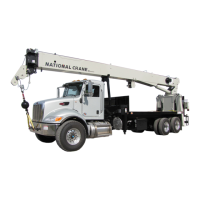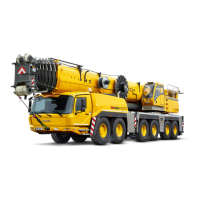SAFETY INFORMATION 999 LUFFING JIB OPERATOR MANUAL
2-10
Published 05-15-17, Control # 043-09
b. The load is secured and properly balanced in the
slings or the lifting device before lifting the load
more than 3 to 6 in (76 to 152 mm).
c. The lift and swing paths are clear of personnel and
obstructions.
d. The load is free to be lifted.
e. The load line is not kinked or otherwise damaged.
f. Multiple part load lines are not twisted around each
other in such a manner that the lines will not
separate when the load is lifted.
g. The hook is brought over the load in a manner that
will minimize twisting or swinging.
h. The load line and the boom hoist rope are properly
spooled on the drums and seated in the sheaves.
i. The load drum brakes are in proper working order.
The operator shall test the load drum brakes each
time a load approaching the rated load is handled.
Lift the load 3 to 6 in (76 to 152 mm) and fully apply
the brakes — load must not lower through applied
brakes.
j. Unused load drums are parked (working and
parking brakes applied. If equipped, drum pawls
engaged).
k. All personnel are clear of the swing radius of the
crane’s counterweight.
2. While lifting or moving the load, the operator shall take
the following precautions:
a. Accelerate and decelerate the load smoothly to
avoid excessive stress on the crane boom and
machinery.
b. Avoid sudden starts and stops while swinging. Keep
the swing speed under control to prevent the load
from swinging out beyond the radius at which the
load can be handled and to minimize the pendulum
action of the load.
c. Sound the signal horn before swinging and
intermittently while swinging, especially when
approaching personnel.
If equipped, the automatic swing alarm will sound
when the crane is swung.
d. Use taglines or other restraints to control the load
when necessary.
e. Do not exceed any swing limitations (areas of
operation) given in the Capacity Chart.
f. Do not allow the load, the boom, or any other part of
the crane to contact obstructions.
g. Do not use the crane to drag a load.
h. Do not hoist, lower, or swing the load while
personnel are on the load or the hook. See
Personnel Handling in this section.
i. Avoid carrying the load over personnel. Loads
which are suspended must be blocked or cribbed
before personnel are allowed to work under or
between them.
j. Before lifting a load which requires the use of
outriggers (or anytime outriggers are used), fully
extend the outrigger beams and jacks so the truck
tires do not bear any load.
Securely fasten the outrigger jack pads or floats to
jacks and set them on a flat, firm surface that will
support the load placed on the pads or floats. Do not
set the jack pads or floats in holes, on rocky ground,
or on extremely soft ground.
When dictated by ground conditions, install wood
blocking or steel plates under the jack pads or floats
to properly distribute the loading on the supporting
surface.
Wood blocking or steel plates used under the jack
pads or floats must be:
- Free of defects
- Strong enough to prevent crushing, bending, or
shear failure
- Of sufficient thickness, width, and length to
completely support the jack pad or float,
transmit the load to the supporting surface, and
prevent shifting, toppling, or excessive
settlement under load
k. Fully retract and lock the jacks and the outrigger
beams so they cannot extend when not in use.
l. Operate with extreme caution when using two or
more cranes to lift the same load.
One designated person shall be responsible for
operation when two or more cranes are used to lift
same load. The designated person shall analyze the
lift and instruct all personnel involved in proper
rigg
ing and positioning of the load and all
movements to be made. Decisions such as the
necessity to reduce crane ratings, load position,
boom position, ground support, and speed of
movements must be in accordance with the
designated person’s decision.
m. Do not lower the load or the boom to a point where
less than three full wraps of wire rope are remaining
on the respective drum (or as otherwise indicated in
local, state, or federal regulations).
n. Engage the boom hoist pawl when operating with
the boom at a fixed radius.

